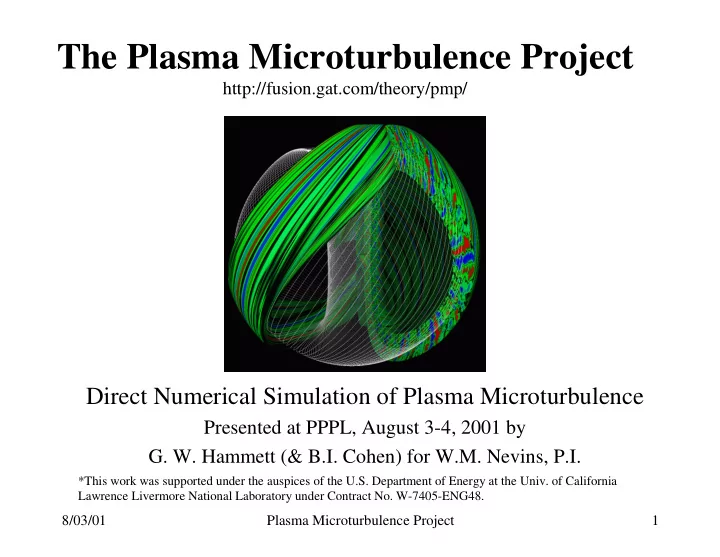

The�Plasma�Microturbulence�Project http://fusion.gat.com/theory/pmp/ Direct�Numerical�Simulation�of�Plasma�Microturbulence Presented�at�PPPL,�August�3-4,�2001�by G.�W.�Hammett�(&�B.I.�Cohen)�for�W.M.�Nevins,�P.I. *This�work�was�supported�under�the�auspices�of�the�U.S.�Department�of�Energy�at�the�Univ.�of�California� Lawrence�Livermore�National�Laboratory�under�Contract�No.�W-7405-ENG48. 8/03/01 Plasma�Microturbulence�Project 1
Computer�Simulations�—A�Testbed for� Understanding�Turbulent�Transport Turbulent�plasma�transport�is: � An�important�problem: Size�of�an�ignition�experiment�determined�by fusion self-heating ⇔ turbulent�transport�losses � A�challenging�problem: Turbulence�is�the�outstanding�unsolved�problem� of�classical�physics � A�terascale problem� Teraflop computers�make�high�resolution�simulation� of�the�full�set�of�fundamental�equations�possible 8/03/01 Plasma�Microturbulence�Project 2
Computational�Center�for�the�Study�of� Plasma�Microturbulence • Development�and�applications�of�advanced�gyrokinetic� simulations,�and�comparisons�to�theory�and�experiment • Development�and�deployment�of�shared�software�tools,� including�interfaces,�diagnostics,�and�analysis�tools • Establishment�of�a� Summer�Frontier�Center�for�Plasma� Microturbulence • Multi-institutional�team:�GA,�LLNL,�PPPL,UMD,�CU,� UCLA.������(P.I.=Bill�Nevins) • Project�builds�on�experience�and�investment�in�Num.� Tok.�Turb.�Project�and�leverages�off�OFES�Theory�base� program. 8/03/01 Plasma�Microturbulence�Project 3
Why�is�Simulation�of�Plasma�Turbulence�Important ? • Energy�confinement�is�key�problem�in�MFE Confinement�quality�measured�by� n τ E T – n τ E T~10 21� keV-s/m 3 – Current�experiments�have�achieved� n τ E T~10 22� keV-s/m 3 – Burning�plasma�experiment�requires� Facility�cost�scales�(roughly)�with�n τ E T – • Dominant�energy�loss�mechanism�in�magnetic�confinement� devices�is�turbulent�transport � Understanding�turbulent�transport�would�allow�us�to�get�more� n τ E T�for�the�same�dollars • Direct�numerical�simulation of�turbulence�is�a�cost-effective�and� easily�diagnosed�proxy�for�very�expensive�experiments.� Simulations�facilitate�understanding�and�are�necessary�to�develop� a�predictive�modeling�capability. 8/03/01 Plasma�Microturbulence�Project 4
The�Plasma�Microturbulence�Project� Has�Produced�Results • Numerous�invited�talks�at�‘00�&�‘01�APS-DPP,�‘00�IAEA,�‘01�TTF,�and�‘01� Sherwood:����Dimits,�et�al.,�IAEA�‘00;�Dorland,�IAEA�‘00;�Lin�et�al.,�IAEA� ‘00;�Y.�Chen,�APS-DPP�‘00;�Nevins,�APS-DPP�‘00;�Cohen,�APS-DPP�‘01;� Waltz,�APS-DPP�‘01;�Jenko,�Sherwood�‘01;�Leboeuf,�Sherwood�‘01;�Candy� and�Waltz,�EPS�‘01;�Jenko,�EPS�‘01;�Hallatschek TTF�‘01;�etc. • Numerous�publications�in�refereed�journals:�����Dorland,�et�al.,�PRL� 85 (‘00);� Rogers,�Dorland,�et�al.,�PRL� 85 (‘00);�Y.�Chen�and�Parker,�PoP 8 ,�441�&� 2095�(‘01);�Dimits,�et�al.,�Nuc.�Fusion� 41 ,�(‘01);�Kim�&�Parker,�J.Comp.Phys.� 16 (‘00);�Leboeuf,�et�al.,�PoP 7 (‘00);�Lin�and�Chen,�PoP 8 (‘01);�Rettig,� Leboeuf,�et�al.,�PoP 8 ,�(‘01);�Snyder�&�Hammett,�PoP 8� (‘01);�etc.� • Experimental�contributions: Budny�(JET),�McKee�(DIII-D),�Murakami�(DIII- D)�IAEA�’00,�Kinsey�(DIII-D)�PRL�’01.�Ernst�(TFTR)�PoP�’00,�many�others. • The�PMP�has�had�the�single�largest�allocation�at�NERSC�for�a�few years. 8/03/01 Plasma�Microturbulence�Project 5
The�Physics�Model Magnetic�Coordinates: Reduced�Maxwell’s�Equations B = ∇ ∇ ∇ ∇α×∇ ∇ ∇ ∇ψ Perturbed�5-D�distribution�function: Electrostatic�potential: h s =h s ( ψ , α , θ , ε , µ ) 2 v q φ ∂ F ( ) � � � � ∇ ⊥ 2 φ = 4 π ∂ε + J 0 k ⊥ v ⊥ 0 q d h Ω � � Gyrokinetic�equation: s ∂ � � δ B ⊥ : + ˆ ⋅ ×∇ Φ ⋅ ∇ + || ˆ ⋅ ∇ + ω � � b v b i h ∂ d � � t || = − 4 π ( ) � ∂ ∂ Φ 2 A � ∇ ⊥ k ⊥ v ⊥ 2 v � qv || J 0 F d h = ω Φ − T 0 Ω i q ∂ε ∂ c * t δ B || : s where: ( ) ( ) k ⊥ v ⊥ δ B ( ) φ − v || � J 1 2 � mv ⊥ k ⊥ v ⊥ Ω δ B B = − 4 π Φ = J 0 k ⊥ v ⊥ � + 2 J 1 || � Ω c A � � Ω 2 v � mv ⊥ || || k ⊥ v ⊥ d h q B Ω 2 k ⊥ v ⊥ B Ω s 8/03/01 Plasma�Microturbulence�Project 6
Plasma�Turbulence�Simulation� Codes�Already�Developed • Builds�on�NTTP�effort� • Realistic�Geometry�&� efficient�grids�aligned� << k with� B�� (����������������) : k || ⊥ – Flux-tube�codes – Global�codes� • Efficient�Algorithms � Gyrokinetic—Continuum � Gyrokinetic—PIC • Demonstrated�scaling�to� 100’s�of�processors 8/03/01 Plasma�Microturbulence�Project 7
Plasma�Microturbulence�Project� Relies�on�a�Small�Suite�of�Codes • PMP�code�suite:�2x2�matrix�of�global�and�flux-tube�codes�using� gyrokinetic�Vlasov continuum�and�particle�methods.��Building�shared� back�ends�for�diagnostics�and�visualization,�shared�front�end�for� experimental�data�interfaces. • Both�global�and�flux-tube�codes�are�needed.�Flux-tube�is�more� efficient�for�parameter�studies,�does� not trip�over�problems�of�plasma� particle�and�energy�sources�or�profile�relaxation,�and�more�readily� includes�physics�at�scales�less�than�the�ion�Larmor radius�(e.g.,�ETG).�� Global�(nonlocal)�accommodates�equilibrium�profile�variations�and� scaling�wrt�Larmor�radius�over�minor�radius�nonperturbatively. • Vlasov continuum�and�particle�approaches�have�different� computational�advantages/disadvantages.�Having�two�approaches�has� been�vital�for�cross-checking�results�and�error�correction,�and�has� provided�opportunities�for�innovation�and�creativity. 8/03/01 Plasma�Microturbulence�Project 8
Existing�Codes�(I)� Gyrokinetic�Particle�Codes • Integrates�GKE�along� Number�of�Particles�-�Timestep�/�Second 107 T3E characteristics� � Many�particles�in�5-D� Origin�2000 106 phase�space Cray-C90 � Interactions�through� 105 self�consistent�electric� &�magnetic�fields Cray-J90 104 � Particles�advanced������ 1 10 100 1000 in�parallel Number�of�Processors 8/03/01 Plasma�Microturbulence�Project 9
Existing�Codes�(II): 5-D�Continuum�Codes • Solves�GKE�on�a�grid�in�5-D� phase�space�(multiple�domain� decomposition�used) • Eliminates�discrete�particle� noise • Linear�physics�is�handled� implicitly�in�GS2 � Kinetic�electrons�&� electromagnetism�have�less� impact�on�time�step • Global�code�GYRO�is� explicit,�uses�advanced�CFD� methods. 8/03/01 Plasma�Microturbulence�Project 10
Under�PSACI�Auspices�the PMP�Proposal�Was�Approved�to: • Explore�new�regimes�of�plasma�microturbulence using� existing�and�newly�developed�codes • Develop�advanced�simulation�algorithms�for – New�generations�of�computers,�e.g.,�IBM�SP – New�physics�capabilities,�e.g.,�kinetic�electrons�and� electromagnetic�fluctuations • Build�advanced,�shared�diagnostics to�provide�a�bridge� between�simulation�effort�and�theory�&�experimental� communities 8/03/01 Plasma�Microturbulence�Project 11
Recommend
More recommend